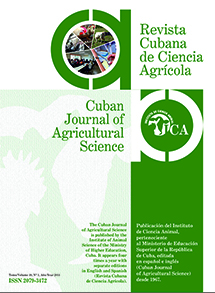Study of morphoagronomic indicators of Cenchrus purpureus clones for biomass production
Contenido principal del artículo
Resumen
Using a randomized block design with four replications, clones of Cenchrus purpureus (CT-6, CT-9, CT-13, CT-15, CT-24 and CT-28) obtained by in vitro tissue culture were evaluated and compared with their progenitor (CT-115) in typical red Ferralitic soil, for two years without irrigation and fertilization. In both evaluation years during the seasonal periods the height differed (P<0.001) between the clones and the CT-28 surpassed the CT-115 was highlighted. There were differences (P <0.001) in the percent of DM and their values varied in narrow range (17-23 % and 19-21 % in the dry and rainy season, respectively). With the exception of CT-24, the rest of clones showed leaves contents higher than 50 % and differed among them, but the highest value (64.88 %, P <0.001) was showed by
CT-28 during the rainy season. The leaves length varied (P <0.0001) between clones and CT-9 was highlighted in both years (73.73 and 84.23 cm for the dry and rainy season, respectively for the first year and 68.6 and 76.7 cm for similar stages of the second year). Similar response pattern was obtained in the leaf width. The leaf area also differed between clones and the highest values were recorded in the rainy season of both years. There were significant differences between the clones in the seasonal and annual DM yield and the clones CT-9, CT-15, CT-24 and CT-28 were highlighted. There were also significant differences in the population of the clones at the beginning and end of the experiment, but when comparing these two stages there were not variation and the values ranged between 5.43 and 9.49 bunches/5m. In general terms, the studied indicators varied when comparing the studied years. There is a group of clones with favorable characteristics for forage production, where CT-9 and
CT-28 were highlighted. Future studies using strategic fertilization and irrigation of promising clones are suggested.
Key words: height, yield, leaves, population, leaf area
CT-28 during the rainy season. The leaves length varied (P <0.0001) between clones and CT-9 was highlighted in both years (73.73 and 84.23 cm for the dry and rainy season, respectively for the first year and 68.6 and 76.7 cm for similar stages of the second year). Similar response pattern was obtained in the leaf width. The leaf area also differed between clones and the highest values were recorded in the rainy season of both years. There were significant differences between the clones in the seasonal and annual DM yield and the clones CT-9, CT-15, CT-24 and CT-28 were highlighted. There were also significant differences in the population of the clones at the beginning and end of the experiment, but when comparing these two stages there were not variation and the values ranged between 5.43 and 9.49 bunches/5m. In general terms, the studied indicators varied when comparing the studied years. There is a group of clones with favorable characteristics for forage production, where CT-9 and
CT-28 were highlighted. Future studies using strategic fertilization and irrigation of promising clones are suggested.
Key words: height, yield, leaves, population, leaf area
Detalles del artículo
Cómo citar
Herrera, R., Fortes, dayleni, García, M., & Cruz, A. M. (2019). Study of morphoagronomic indicators of Cenchrus purpureus clones for biomass production. Cuban Journal of Agricultural Science, 53(2). Recuperado a partir de https://mail.cjascience.com/index.php/CJAS/article/view/886
Sección
Ciencia de los pastos y otros cultivos
Aquellos autores/as que tengan publicaciones con esta revista, aceptan los términos siguientes:
- Los autores/as conservarán sus derechos de autor y garantizarán a la revista el derecho de primera publicación de su obra, el cuál estará simultáneamente sujeto a la Licencia Creative Commons Attribution-NonCommercial 4.0 International (CC BY-NC 4.0) que permite a terceros compartir la obra siempre que se indique su autor y su primera publicación esta revista. Bajo esta licencia el autor será libre de:
- Compartir — copiar y redistribuir el material en cualquier medio o formato
- Adaptar — remezclar, transformar y crear a partir del material
- El licenciador no puede revocar estas libertades mientras cumpla con los términos de la licencia
Bajo las siguientes condiciones:
- Reconocimiento — Debe reconocer adecuadamente la autoría, proporcionar un enlace a la licencia e indicar si se han realizado cambios. Puede hacerlo de cualquier manera razonable, pero no de una manera que sugiera que tiene el apoyo del licenciador o lo recibe por el uso que hace.
- NoComercial — No puede utilizar el material para una finalidad comercial.
- No hay restricciones adicionales — No puede aplicar términos legales o medidas tecnológicas que legalmente restrinjan realizar aquello que la licencia permite.
- Los autores/as podrán adoptar otros acuerdos de licencia no exclusiva de distribución de la versión de la obra publicada (p. ej.: depositarla en un archivo telemático institucional o publicarla en un volumen monográfico) siempre que se indique la publicación inicial en esta revista.
- Se permite y recomienda a los autores/as difundir su obra a través de Internet (p. ej.: en archivos telemáticos institucionales o en su página web) antes y durante el proceso de envío, lo cual puede producir intercambios interesantes y aumentar las citas de la obra publicada. (Véase El efecto del acceso abierto).
